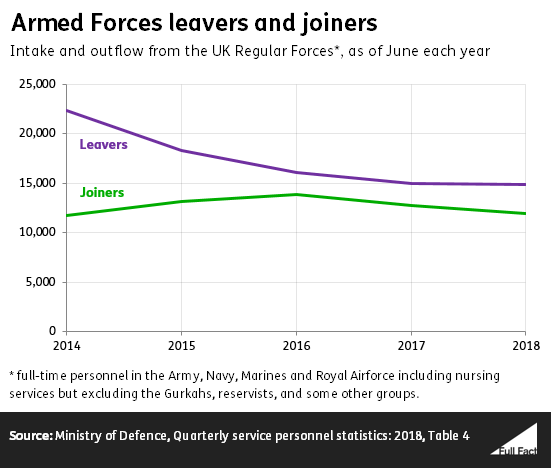Are the UK’s armed forces recruiting enough people?
The government recently announced that it would be relaxing the rules for Commonwealth citizens wishing to join the UK’s armed forces with the aim of increasing the number of Commonwealth recruits to around 1,350 a year.
With that in mind we took a look at what’s been happening to armed forces recruitment.
Honesty in public debate matters
You can help us take action – and get our regular free email
The size of the armed forces is about 9,000 below target
There were just over 192,000 military personnel employed by the UK armed forces as of the start of July 2018. That figure includes the Army, Royal Navy, Marines and Royal Air Force (RAF) as well as the Gurkhas, a division of the Army with Nepalese recruits, and a number of reserve and guard services.
Of these the full-time trained size of the armed forces was around 136,000. That’s around 9,000 below the government’s target.
The Army has the widest gap between its actual numbers and its target size (around 7%), the RAF is about 6% away from its target, while the Navy and Marines are around 4% away. The combined gap across all forces is about 6%.
Earlier this year the National Audit Office, the public spending watchdog, said that “the aggregate figures mask much larger shortfalls in the number of regulars with critical skills, such as engineers, pilots and intelligence analysts.”
More people are leaving the armed forces than joining
We have figures on the numbers joining and leaving the UK Regular Forces each year—that’s full-time personnel including nursing services but excluding the Gurkahs, reservists, and some other groups.
In the year to June 2018 around 12,000 personnel joined the UK Regular Forces, and around 15,000 left—altogether a loss of around 3,000 people. In the previous year, almost 13,000 joined and around 15,000 left—a loss of around 2,000 people.
Recent changes to recruitment
The Ministry of Defence has recently made announcements about how recruitment to the armed forces will change.
At the start of November it was announced that the five-year residency requirement for citizens of Commonwealth countries to join the UK’s armed forces was being removed—under the new scheme being phased in (over several years) all Commonwealth citizens over the age of 18 can apply. The changes don’t apply to people wanting to join the reserves (they will still need to fulfil the residency requirement) and the government said the new rules also won’t affect personnel from Ireland or those joining the Gurkhas who have different rules already.
The government hopes that this will increase the number of people from the Commonwealth recruited into the armed forces to 1,350 each year.
The rule about five years of residency was re-introduced in 2013, although from 2016 up to 200 Commonwealth applicants per year who didn’t meet the residency requirements could apply to certain posts where there were skills shortages.
In October it was announced that infantry roles in the Army and roles in the Royal Marines were to be opened to women for the first time.
Unlike the new announcement regarding Commonwealth applicants, the government suggests that this isn’t really aimed at increasing recruitment, saying that “the military does not necessarily expect large numbers of women to apply for ground close combat roles”. Instead the changes are aimed at providing equal opportunities for military personnel.
